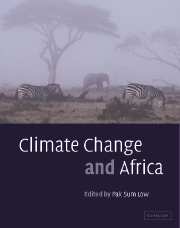Book contents
- Frontmatter
- Contents
- Notes on contributors
- Peer reviewers
- Editor's note
- Foreword
- Foreword
- Foreword
- Foreword
- Preface
- Preface
- Preface
- Preface
- List of abbreviations
- List of SI prefixes
- List of unit abbreviations
- List of chemical formulae
- Part I Science
- Part II Sustainable energy development, mitigation and policy
- Part III Vulnerability and adaptation
- Part IV Capacity-building
- Part V Lessons from the Montreal Protocol
- Index
Preface
Published online by Cambridge University Press: 10 December 2009
- Frontmatter
- Contents
- Notes on contributors
- Peer reviewers
- Editor's note
- Foreword
- Foreword
- Foreword
- Foreword
- Preface
- Preface
- Preface
- Preface
- List of abbreviations
- List of SI prefixes
- List of unit abbreviations
- List of chemical formulae
- Part I Science
- Part II Sustainable energy development, mitigation and policy
- Part III Vulnerability and adaptation
- Part IV Capacity-building
- Part V Lessons from the Montreal Protocol
- Index
Summary
Droughts, floods, storms and other climatic phenomena are natural features of planet Earth and have been occurring for millions of years. The earliest humans, cradled in Africa, learned over time how the seasonal rains came and went. They observed how in some years the rains could be excessive, deficient or untimely, sometimes with disastrous consequences, and gradually they developed ways to better cope with the uncertainties. Episodes of significant climate shifts stretching for tens and hundreds of years also occurred and forced major shifts in the locations and activities of societies.
Today, our understanding of the rains is scientific and extensive, yet the continent suffers more and more from the vagaries of the climate. Drought in particular affects millions of people each year – people who are often already suffering from poverty and disease and who are least able to resist or cope with the added stress of food and water shortages. And on the horizon there is the looming threat that climate change may make matters even worse.
For many, there seems no escape from the repeated impacts of climatic hazards. But closer examination shows that disasters occur only when the hazard is coupled to human vulnerability. Surprisingly, it is the human situation that mainly causes the problem – especially populations in risky and degraded locations without the means to understand and avoid or manage the risks. Disasters are thus a manifestation of poverty, inadequate governance, meagre public services, and unsustainable development.
- Type
- Chapter
- Information
- Climate Change and Africa , pp. xxxiiPublisher: Cambridge University PressPrint publication year: 2005

